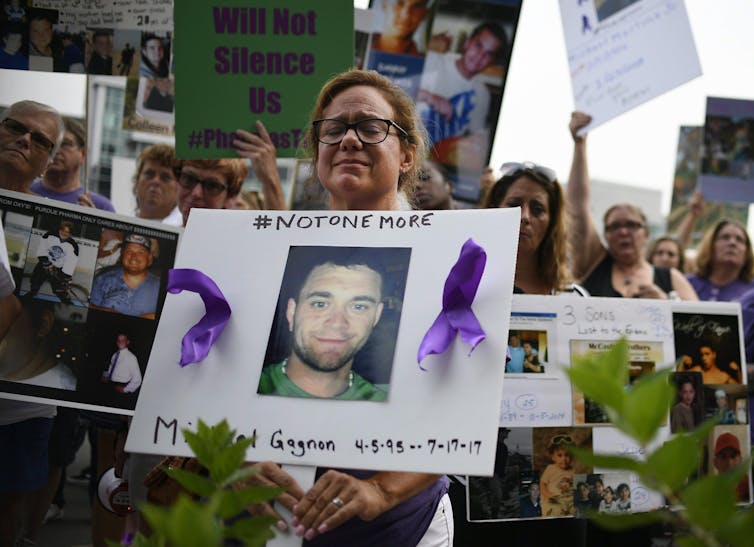A United States congressional report revealed last year that five opioid manufacturers made more than $10 million in payments to patient advocacy groups and professional societies between 2012 and 2017.
Initiatives from these advocacy groups and professional societies often echoed and amplified recommendations to increase opioid use. For example, they promoted opioid for chronic pain, minimized the risk of addiction and criticized the Center of Disease Control and Prevention (CDC) guidelines to limit opioid prescriptions.
In addition, opioid manufacturers used these groups to lobby Congress to change laws directed at curbing opioid use. This, according to the report, “may have played a significant role in creating the necessary conditions for the U.S. opioid epidemic.”
Patient advocacy groups play an important role in democratic societies, giving voice to vulnerable populations, shaping health policy debates and acting to influence public policies to promote their members’ interests and needs.
When funded by the industry, however, they often serve merely as a marketing tool — promoting corporate interest.
To date, there has been no attempt to systematically investigate the relationships between opioid manufacturers and pain advocacy groups and societies in Canada. However, evidence shows that, similar to the U.S., opioid manufacturers fund such organizations in Canada.
Advocacy groups echo corporate interest
In Health Advocacy Group Inc: How Pharmaceutical Funding Changed the Breast Cancer Movement, bioethicist Sharon Batt explores the alliance between patient-group advocacy and pharmaceutical companies in Canada. She suggests that this relationship can distort policies that have been put in place to protect public health.
Batt questions the ability of such groups to speak on behalf of people who need help, and shows how advocacy groups today echo the demands of pharmaceutical companies that are often counter to its members interests.

Christine Gagnon of Southington, Conn. protests with other family and friends who have lost loved ones to OxyContin and Opioid overdoses at Purdue Pharma LLP headquarters in Stamford, Conn., Aug. 17, 2018. (AP Photo/Jessica Hill)
For example, in 2005 the Canadian Pain Society arranged a pain management event, supported by an unrestricted educational grant from Purdue Pharma Canada, the manufacturer of OxyContin. A conference held by the same society in 2007 included a Purdue Pharma symposium.
In another case, the Chronic Pain Association of Canada received money from Eli Lilly Canada Inc., Purdue Canada Inc. and Merck Frosst Canada.
A blog post on the association’s website contains messages favourable to increased opioid use and criticizes arguments questioning opioid effectiveness, calling it “anti-opioid hysteria and propaganda” caused by prominent “anti-opioid activists.”
Two years ago, Purdue donated just shy of $1 million to Canadian health-care organizations, some of which could have been patient groups. (The way the information is reported doesn’t allow us to identify which health-care organizations received money.)
All payments should be disclosed
We believe this marketing tactic is undesirable and might have contributed to the opioid epidemic in Canada as it did in the U.S.
Furthermore, using the vulnerability and the suffering of patients as a tool for maximizing profit is morally wrong.
Lack of transparency surrounding the advocacy groups is a real problem. Neither the industry nor advocacy organizations are required to fully and routinely disclose their financial ties.
Indeed, some patient organizations question why they should disclose sources of donations in the first place. Two such groups commented: “We do not see the purpose of asking how much money has been contributed by any entity that may have an interest” in a recommendation about whether a drug should be funded by a provincial drug plan.
We call for the Canadian government to examine and disclose all payments from pharmaceutical companies to non-profit patients’ advocacy groups and societies.



 Morgan Stanley Boosts Nvidia and Broadcom Targets as AI Demand Surges
Morgan Stanley Boosts Nvidia and Broadcom Targets as AI Demand Surges  Eli Lilly Becomes First Pharma Giant to Hit $1 Trillion Amid Soaring Weight-Loss Drug Demand
Eli Lilly Becomes First Pharma Giant to Hit $1 Trillion Amid Soaring Weight-Loss Drug Demand  Amazon Italy Pays €180M in Compensation as Delivery Staff Probe Ends
Amazon Italy Pays €180M in Compensation as Delivery Staff Probe Ends  Microchip Technology Boosts Q3 Outlook on Strong Bookings Momentum
Microchip Technology Boosts Q3 Outlook on Strong Bookings Momentum  UPS MD-11 Crash Prompts Families to Prepare Wrongful Death Lawsuit
UPS MD-11 Crash Prompts Families to Prepare Wrongful Death Lawsuit  FDA Pilot Program Eases Rules for Nicotine Pouch Makers
FDA Pilot Program Eases Rules for Nicotine Pouch Makers  Sam Altman Reportedly Explored Funding for Rocket Venture in Potential Challenge to SpaceX
Sam Altman Reportedly Explored Funding for Rocket Venture in Potential Challenge to SpaceX  Mexico Probes Miss Universe President Raul Rocha Over Alleged Criminal Links
Mexico Probes Miss Universe President Raul Rocha Over Alleged Criminal Links  Innovent’s Xinermei Intensifies Weight-Loss Drug Battle in China
Innovent’s Xinermei Intensifies Weight-Loss Drug Battle in China  Bayer’s Stroke Drug Achieves Breakthrough Trial Results, Boosting Market Confidence
Bayer’s Stroke Drug Achieves Breakthrough Trial Results, Boosting Market Confidence  GM Issues Recall for 2026 Chevrolet Silverado Trucks Over Missing Owner Manuals
GM Issues Recall for 2026 Chevrolet Silverado Trucks Over Missing Owner Manuals  IKEA Launches First New Zealand Store, Marking Expansion Into Its 64th Global Market
IKEA Launches First New Zealand Store, Marking Expansion Into Its 64th Global Market  Wikipedia Pushes for AI Licensing Deals as Jimmy Wales Calls for Fair Compensation
Wikipedia Pushes for AI Licensing Deals as Jimmy Wales Calls for Fair Compensation  Brazil’s Supreme Court Orders Jair Bolsonaro to Begin 27-Year Prison Term
Brazil’s Supreme Court Orders Jair Bolsonaro to Begin 27-Year Prison Term  U.S. Experts to Reassess Newborn Hepatitis B Vaccination Guidelines Amid Growing Debate
U.S. Experts to Reassess Newborn Hepatitis B Vaccination Guidelines Amid Growing Debate  Bitcoin Defies Gravity Above $93K Despite Missing Retail FOMO – ETF Inflows Return & Whales Accumulate: Buy the Dip to $100K
Bitcoin Defies Gravity Above $93K Despite Missing Retail FOMO – ETF Inflows Return & Whales Accumulate: Buy the Dip to $100K 






























